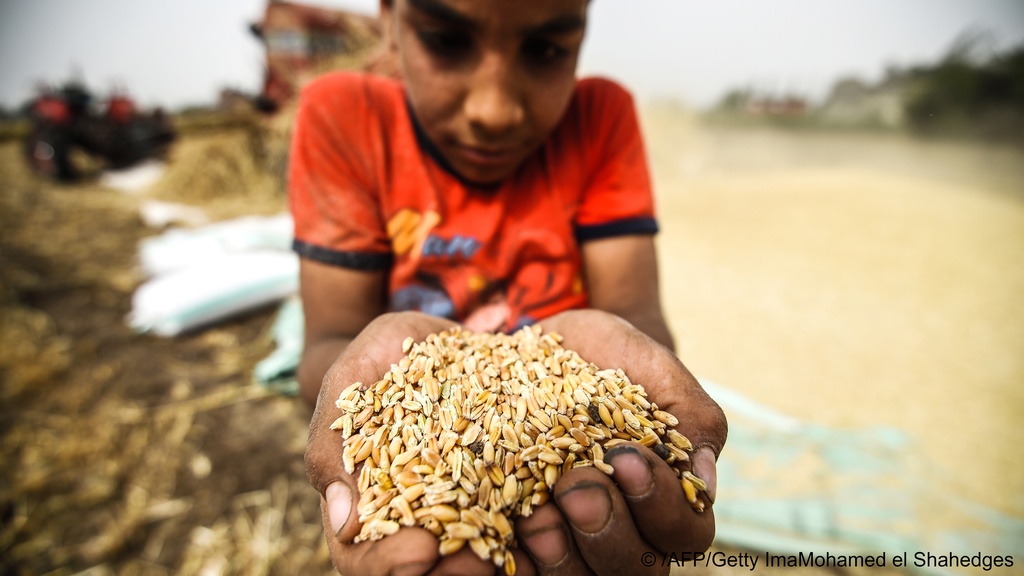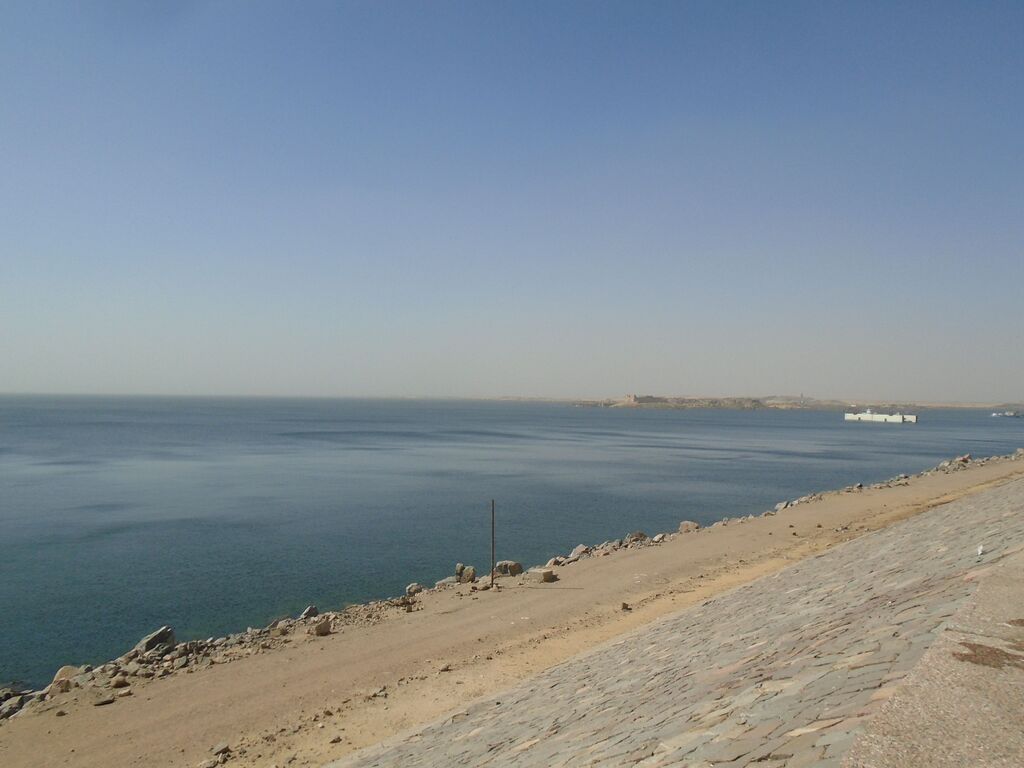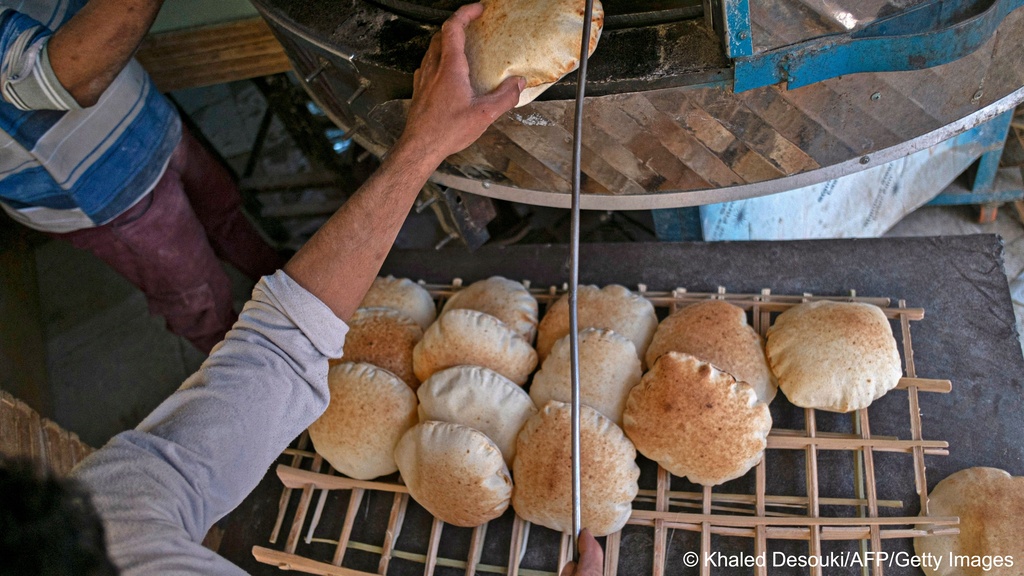Wheat from the desert?

The drive from Aswan in Upper Egypt to the Sudanese border is very monotonous: the road is as straight as a die, and there is desert as far as the eye can see. It is 250 kilometres of pale brown earth, peppered from time to time with black and grey rocks. The heat is so searing that water seems to shimmer on the road's surface. But it is just a mirage. Then, out of the blue, fields come into view: flecks of green in the middle of the desert.
The green in question turns out to be wheat. To the left of the road is a village; to the right a high wall stretching kilometre after kilometre into the distance. The wall is intended to keep out thieves. After all, wheat is now an even more highly prized commodity in Egypt than it already was.
The price of wheat, which is needed to bake bread, is currently reaching record levels. Toshka, which is situated in the very south of Egypt, just a few kilometres from the Sudanese border, is Egypt's great hope in this respect. The intention is that this project, which was launched 20 years ago, but has been completely neglected ever since, will prevent starvation and hunger.
The war in Ukraine has not only shaken Europe, but is also causing massive dislocations globally. For many countries, Russia and especially Ukraine were their breadbasket. Egypt in particular, the most populous country in the Middle East, is dependent on wheat imports to feed its more than 100 million inhabitants. Bread is the most important staple food in Egypt. For Egyptians, bread is life. Indeed "aish", the Egyptian Arabic word for bread, actually means "life".
According to the UN Food and Agriculture Organisation, however, almost 25 million tonnes of grain are stuck in Ukraine alone. Egypt faces a huge problem, because 80 percent of the Nile country's wheat imports came from Ukraine and Russia before the war. According to UN studies, 31 developing countries are already insolvent or at high risk of becoming so soon, thereby increasing the risk of bread riots.

Cairo is currently working flat out to produce more wheat. In an attempt to turn the desert green, the Egyptian government has come up with a three-step plan. "This year, the government has provided just under 102,000 hectares of land for wheat cultivation and intends to double this figure next year," explains Aladdin Hamwieh, biotechnologist at the International Center for Agricultural Research in the Dry Areas (ICARDA), which has close links to the government. "And that's in addition to over 600,000 hectares of land that we have cultivated in recent years. Wheat is now being cultivated not only in the fertile Nile Delta, but also in the desert regions of Upper Egypt, even though higher levels of fertiliser are needed there because the ground is so dry."
Mubarak's plan to green the desert
Whether anything will actually come of these plans is an entirely different matter. Many a bombastic plan has been hatched in Egypt only to sink into the desert sands. The greening of the desert is just one of them; the expansion of the country's agricultural sector another. Every Egyptian president – from Gamal Abdel Nasser and Anwar al-Sadat to Hosni Mubarak and Abdul Fattah al-Sisi – has spoken of self-sufficiency and pledged to make more land available for agriculture. But virtually nothing has been done. The land in question was not ultimately used for growing crops, but for building houses and villas. Corruption played a major role in this development. Cheap agricultural land was turned into prime real estate.
The plan is that Toshka will change everything. When Hosni Mubarak officially opened the pumping station named in his honour on 12 January 2003, hundreds of journalists (including the author of this piece) flew from Cairo to Abu Simbel to see and report on what was billed as "the project of the century". The Swiss company Schindler built an expensive lift especially for the occasion. The lift was used to carry the president and his entourage 50 metres up and then down again.
This was the distance that the water would be pumped from Lake Nasser into the irrigation channel that was supposed to green the desert. At the time, the Mubarak pumping station was the biggest of its kind in the world. But the irrigation channel was not complete at the time of the opening ceremony and it still isn't. The intention was that by 2017, the Toshka project would result in the creation of jobs and homes for three million people in an area measuring 420,000 hectares. This would have increased habitable land in Egypt from five percent of the country's total surface area to over 20 percent.

All that has happened was that a small village has been built alongside the road to Sudan. Some 90 percent of Egypt's total surface area is still uninhabitable. The original idea of enticing agricultural students from the universities of Cairo and Alexandra to the south of the country, providing them with free arable land, seeds and fertiliser in order to motivate them to cultivate crops, did not work. Most of the students who made the journey to Toshka soon returned, shaking their heads. They told of a lack of infrastructure such as railway lines, air links, markets and distribution channels. "Water alone is not enough," they said. And so, Toshka became yet another project to sink into the desert sands.
A danger of bread riots
"The government must do something," say the people on the streets of Cairo. "Otherwise there will soon be bread riots." For years, the state has been pumping millions into bread production. Now that the price of wheat has skyrocketed, it will have to pump even more into it. One third of the population already lives below the poverty line and the number is growing by the day. Non-subsidised bread has got 50 percent more expensive in recent weeks.
Although the price of subsidised bread is still the same, the size of the bread – which still costs an Egyptian pound – has become smaller. The plan now is to plant wheat quickly. Farmers have been promised certified seeds that will give higher yields. The government has also promised to buy over six million tons of wheat at a fixed price to ensure the success of the urgently needed food programme. Aladdin Hamwieh of ICARDA says that Egypt "may never" become fully self-sufficient in terms of wheat production, but that an increase of domestic production to cover 70 percent of the amount needed would be a success.
Russia is Egypt's top potato customer and imported ⅔ of its potato consumption from Egypt. Main suppliers of onions to Russia are Egypt, Turkey, Uzbekistan & Kazakhstan: Panama flag roro Lider Trabzon transits Bosphorus towards #BlackSea en route from Alexandria to Novorossiysk. pic.twitter.com/tkdqCwQr38
— Yörük Işık (@YorukIsik) May 22, 2022
An increase of 20 percent could cover the rise in demand caused by a 2.5 percent growth in population. After all, two million Egyptians are born every year – a nightmare for any economist.
The final session of parliament before the recess at the end of Ramadan showed just how serious the situation is: the MPs, who generally toe the government line and are loyal to the president, rebelled for the first time and called for the resignation of Prime Minister Mustafa Madbouly. "This government has allowed Egyptians to become impoverished, has burdened them with debt and prevented investment," complained MP Maha Abdel Naser.
Since then, the Egyptian pound has been devalued by 15 percent. Inflation has also shot up 12 percent and is expected to reach 20 percent by the end of the year. Other MPs accused the government of "gross financial transgressions" by giving jobs in the authorities to highly paid consultants who achieved nothing. Incidentally, the wheat in Toshka will not be cultivated by fellahs (Egyptian peasant farmers) but by the Egyptian army, which dominates so many areas of life in Egypt.
Recent reports from Cairo say that attempts are now being made to ship wheat from Ukraine to Egypt via Romania. While that would at least alleviate acute need, it will not solve the problem in the long run.
© Qantara.de 2022
Translated from the German by Aingeal Flanagan